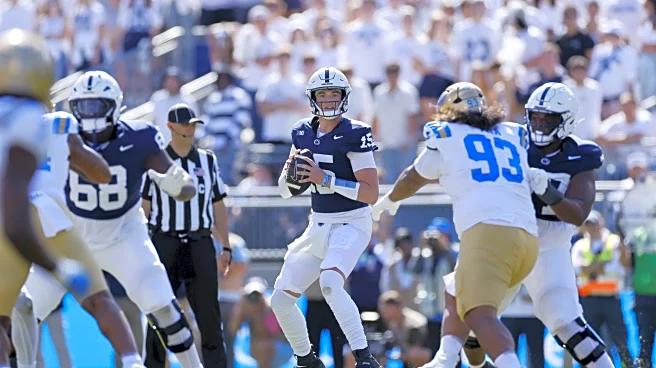No. 7 Penn St. Nittany Lions (3-1; 0-1 Big Ten) vs UCLA Bruins (0-4; 0-1 Big Ten)
3:30 p.m. ET, October 4—CBS
Rose Bowl Stadium (Capacity: 89,702 / Pasadena, CA)
| Difference | > 25 | in | National Rank | |
| Difference | > 50 | in | National Rank | |
| Difference | > 75 | in | National Rank | |
| Difference | > 100 | in | National Rank |
Note:
All of the above rankings are taken directly from the NCAA except for strength of schedule, which is taken from Power Rankings.
The Redzone TD% and Redzone TD% Defense are calculated by me and not ranked by the NCAA. Determining who has the advantage in these categories is strictly my arbitrary judgment.
Quick thoughts:
This feels a little familiar – last year, on the first Saturday in October, the Nittany Lions played their fifth game of the season against the Bruins. Last year, despite the overwhelming
volume of chipmunks on this post, PSU performed below the expectations of many, and only won 27-10 – and that game was at home. As with last year, something to keep in mind when looking at these rankings is the fact that there are 134 teams in the FBS division of NCAA football—I’m not saying, I’m just saying.
This year, the good guys will be looking for a dominant bounce back win against a UCLA team that is as close to free fall as can be, having fired their head coach and likely ending up an underdog or losing in all twelve of the games they’ll be playing this season. How the Penn State team deals with the aftermath of last week’s disappointing double overtime loss, a long with the three-time zone travel, will say a lot about this team and whether they’ll be able to come even close to living up to the preseason hype.
More behind some of these stats:
- Penn State’s offense has been in the red zone 19 times, with an excellent 18 scores (12 touchdowns and 6 field goals); UCLA has been in the red zone fewer times (only 8 through 4 games) but has scored all 8 times, though over half (5) of those scores were field goals
- The Nittany Lion defense has allowed 9 red zone trips with six scores (five TDs to one field goal), while the Bruin defense has allowed 18 red zone trips with 15 scores (14 TDs to one field goal)
- PSU’s offense has attempted 11 fourth down conversions and converted on 8 of them; UCLA’s offense has gone for it 12 times on fourth downs, and also converted 8 times
- Penn State’s defense has faced 16 fourth down conversions attempts and allowed conversions on 11 of them, while UCLA’s defense has faced 8 attempts and allowed conversions on 6 of them
- The Nittany Lions have returned four kickoffs, while the Bruins have returned 12. On the flip side, PSU has faced 8 kickoff returns, while UCLA’s special teams has faced just 5
- Penn State has punted just ten times (with 1 touchback), and UCLA has punted 14 times (with no touchbacks)
- The Nittany Lions have returned 11 punts and defended just three punt return attempts; the Bruins have returned just 2 punts and defended five attempts
Because this game, like last year’s, is the fifth for both teams, I thought it was even more interesting to compare this stats post to last year’s exact same one. Obviously the biggest difference between the two years is in schedules; PSU was undefeated this week last year (though was still ranked #7), while this year’s squad has a loss against a top three team that goes into its year-to-date rankings. In a matchup-by-matchup comparison, the advantage is less this year than last for the Nittany Lions in 16 of the rankings, better for PSU in ten of the rankings, and around the same (with the same number of chipmunks, pushes, or Bruins logos) in 9 categories.
Those differences that I found the most interesting were the Penn State scoring offense vs the UCLA scoring defense (last year: 2 chipmunks to this year’s 4), the PSU rush D vs the UCLA rush O (last year: 5 chipmunks to this year’s 2), the Nittany Lions offense’s fourth down conversion rate vs the Bruin defense’s allowance of conversions (a push last year, and three PSU logos this year), and most especially, penalty yards per game – which last year was a push between the teams, while this year it’s a whopping five-chipmunk advantage for the visiting team.
What say you all?
















